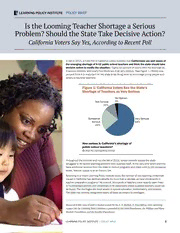
ERIC ED606435: Is the Looming Teacher Shortage a Serious Problem? Should the State Take Decisive Action? "California Voters Say Yes, According to Recent Poll." Policy Brief PDF
Preview ERIC ED606435: Is the Looming Teacher Shortage a Serious Problem? Should the State Take Decisive Action? "California Voters Say Yes, According to Recent Poll." Policy Brief
POLICY BRIEF Is the Looming Teacher Shortage a Serious Problem? Should the State Take Decisive Action? California Voters Say Yes, According to Recent Poll In fall of 2015, a Field Poll of California voters revealed that Californians are well aware of the emerging shortage of K-12 public school teachers and think the state should take decisive action to rectify the situation.1 Eighty-six percent of voters view the shortage as a serious problem, and nearly two-thirds see it as very serious. (See Figure 1.) Ninety-one percent think it is important for the state to be doing more to encourage young people and others to become teachers. Figure 1: California Voters See the State’s Shortage of Teachers as Very Serious No Opinion Not Serious 3% 11% Somewhat Very Serious Serious 64% 22% How serious is California’s shortage of public school teachers? 2016 The Learning Policy Institute Throughout the summer and into the fall of 2015, school districts across the state struggled to fill vacant teaching positions with qualified staff. At the very time when districts have additional revenue from the state to restore programs and class sizes to pre-recession levels, teacher supply is at an historic low. According to a recent Learning Policy Institute study, the number of new teaching credentials issued in California has declined steadily for more than a decade, as have enrollments in teacher preparation programs.2 As a result, thousands of teachers have recently been hired on substandard permits and credentials to fill classrooms where qualified teachers could not be found. The shortages are most severe in special education, mathematics, and science. The state has recently designated nearly all fields as subject to shortages. Research in this area of work is funded in part by the S. D. Bechtel, Jr. Foundation. Core operating support for the Learning Policy Institute is provided by the Ford Foundation, the William and Flora Hewlett Foundation, and the Sandler Foundation. LEARNING POLICY INSTITUTE | POLICY BRIEF 1 Figure 2: California Voters Believe More Teacher Support Is Needed to Address the Teacher Shortage How should California policymakers address the teacher shortage? ■ Extremely Important ■ Somewhat Important Ensure that all teachers receive rigorous training and 65% 29% preparation before they begin teaching Require ongoing professional development and training 62% 30% after teachers receive their credential Provide mentoring and support to recently hired teachers 59% 31% Provide prospective teachers a full year of practice 51% 37% teaching under the guidance of an expert teacher Offer starting salaries that are comparable to the salaries 51% 37% offered to other new college graduates 0% 10% 20% 30% 40% 50% 60% 70% 80% 90% 100% Percent of Voters Agreeing Strategy Is Important 2016 The Learning Policy Institute The poll also found that: As California California voters believe all children deserve access to a fully prepared teacher and do not think the state should reduce standards for teachers in order to staff classrooms. policymakers move to • Eighty-nine percent think it is a serious problem that low-income public schools have address the current fewer qualified teachers than those in wealthier areas. • More than half (52 percent) oppose dealing with shortages by hiring individuals who shortages and prevent have not yet completed their training or earned a teaching credential. a more long-term crisis, California voters expressed broad-based support for policies that are known to be successful at attracting and retaining high-quality teachers. (See Figure 2.) they do not need to • Nearly 90 percent support an expansion of programs modeled after medical residencies start from scratch. that provide prospective teachers with a full year of practice teaching under the Programs developed guidance of an expert teacher. • Approximately 9 in10 support competitive teacher salaries, rigorous preparation before to address earlier eras teaching, supportive mentoring for new teachers, and ongoing professional development for teachers. of shortages—most • Eighty-five percent support loan forgiveness or scholarships for prospective teachers of which have been who agree to teach for at least four years in low-income communities or teach high- priority subjects. eliminated in recent As California policymakers move to address the current shortages and prevent a more years—can point the way. long-term crisis, they do not need to start from scratch. Programs developed to address earlier eras of shortages—most of which have been eliminated in recent years—can point the way. Lawmakers also face big decisions about how to correct teacher imbalances and make teaching a profession that is attractive once again, so talented individuals from diverse backgrounds will want to enter and stay. Acting with foresight now could bring a new generation into the critical work of teaching with the strong preparation needed to provide California’s 6.2 million students with a 21st century education. Endnotes 1530 Page Mill Road, Suite 200 1. The poll, cosponsored by EdSource and the Learning Policy Institute, was conducted by The Field Palo Alto, CA 94304 Poll between September 17 and October 4, 2015. It surveyed a representative sample of 1,002 California registered voters on landlines and cell phones in both English and Spanish. p: 650.332.9797 1301 Connecticut Avenue, Suite 500 2. Linda Darling-Hammond, Roberta Furger, Patrick Shields, and Leib Sutcher, Addressing Washington, D.C. 20036 California’s Emerging Teacher Shortage: An Analysis of Sources and Solutions (Learning Policy Institute, 2016). This report can be found at http://learningpolicyinstitute.org/addressing-ca- p: 202.830.0079 teacher-shortage/. www.learningpolicyinstitute.org LEARNING POLICY INSTITUTE | POLICY BRIEF
